ISSN ONLINE(2319-8753)PRINT(2347-6710)
ISSN ONLINE(2319-8753)PRINT(2347-6710)
| Arul Nicholas .T, V.E.Annamalai Department of Mechanical Engineering, SSN College of Engineering, Kanchipuram, Tamil Nadu, India |
| Related article at Pubmed, Scholar Google |
Visit for more related articles at International Journal of Innovative Research in Science, Engineering and Technology
In grinding process, to remove small quantity of material it consumes high specific energy and produces high temperature in the cutting zone. Heat generation in grinding is due to the shearing of material and friction, which directly influences the workpiece quality. This heat should be controlled within the limit by proper lubrication and cooling. For this purpose cutting fluid is applied during grinding. The main function of cutting fluid is to lubricate as well as to remove the heat. In most of the industries, synthetic cutting fluid is used due to its good lubricating and cooling properties. But on the other hand, they have a significant health and environmental hazard throughout their life cycle. The main aim of this work is to develop an eco-friendly coolant based on bio-degradable additives with water as base coolant. Performance of this novel coolant is compared with existing conventional coolant in grinding application.
Keywords |
| Eco-friendly, natural additive, grinding process, coolant. |
INTRODUCTION |
| Controlling the heat formation during grinding is very important, since this high heat can affect the quality and dimensional accuracy of the work piece. High production rate in grinding obtained with high material removal rate may also increase the grinding temperature. So it has to be removed in an effective way by applying proper coolant. The main function of the coolant is to reduce the frictional heat between tool-workpiece interfaces and to remove heat in tool and work piece. Synthetics, semi-synthetics, straight oil and soluble oil are the four major classes of cutting fluid that are applied for machining [1]. The coolant cost is reported to be around 7 and 17% of the total machining cost [2]. In current scenario growth of environmental awareness and labor health protection policy led to consideration of using eco-friendly coolant and methods for machining applications, since the conventional synthetic coolant used seed to health and environmental hazards [3]. |
| A. Cutting fl uid consideration |
| While selecting the cutting fluid, all it effects from working to disposal should be considered. Many cutting fluids support the growth of bacteria which will affect the life time of cutting fluid and also need to dispose at regular interval [4]. Moreover the cutting fluids are the major source for disorders like skin allergy, respiratory and dietary problems [5]. To maintain the productivity, cutting fluid must be replaced and disposed at regular intervals. The toxic material present in the cutting fluid will contaminate the environment while it is disposed. Biocide, anticorrosive, antifoam and other chemical additives used in coolant can cause hazardous effect on man and environment [3]. Occupational Safety Health Administration, OSHA reported that uses of certain chemicals like ethanolamine, morpholine, nitrodithanolamine, polycyclic aromatic hydrocarbons (PAH), nitrites, glycol ether, oil mist etc are restricted in cutting fluids. |
II. TREND S URVEY |
| To overcome the above mentioned problem, several methods are reported, as stated below: • Dry machining [2]. • Near dry or Minimal quantity lubrication (MQL) [6] [7]. • Cryogenic machining [8]. • Dry lubricant [9]. • Green manufacturing by natural biodegradable cutting fluid [10] [11]. • Compressed gas [12]. |
| Most of the above mentioned methods only reduce the negative effect of cutting fluid, but not fully eliminate the problem created by the conventional coolant. In case of minimum quantity lubrication, the amount of lubrication used for machining is reduced by applying fluid in the form of aerosol directly on cutting zone [6]. But on the other report it has been indicated that MQL is not suitable for heavy machining due to its insufficient cooling effect [7]. The main idea behind solid lubrication is minimizing the frictional heat by proper lubrication. This in turn reduces the machining temperature [9]. An experiment showed that turmeric powder added with water at certain proportion had out performed synthetic coolant [11]. In cryogenic cooling, a super cooled medium, usually liquefied gas is directed into the cutting zone in order to reduce the cutting zone temperature and cool down the tool and work- piece [13]. |
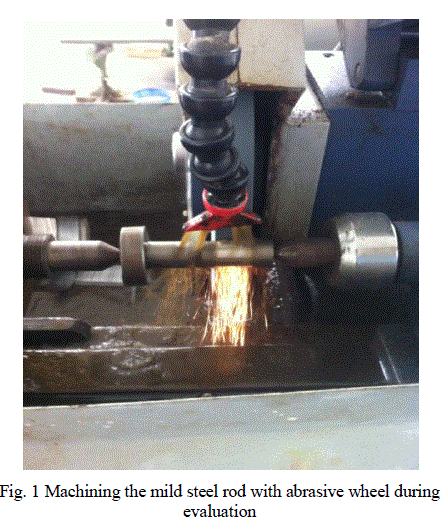 |
III. EXPERIMENTAL SETUP |
| The parameters used for experiment are shown in the following table-1 |
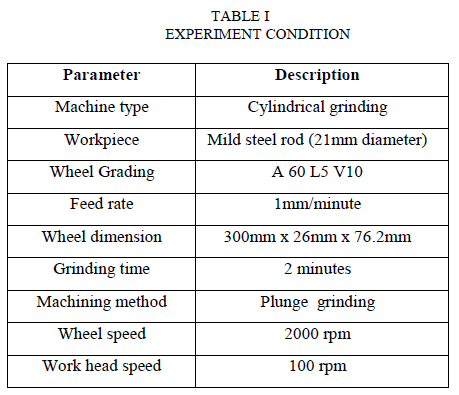 |
| A. Experim ental setup The evaluation of the grinding fluid is performed in cylindrical grinding machine of 1.5 kW output power (as in Fig-1). Initially the wheel is balanced by balancing procedure, then using a diamond blade type dresser, dressing operation is performed. The initial diameter of the wheel and the wheel weight for calculating wheel density and the workpiece weight are recorded. |
| The workpiece is fixed in the chuck. The workpiece and wheel are fixed on the machine. The machine is run with above mentioned parameters. The initial power and final power are recorded. The wheel is removed and the final diameter is recorded. Feed rate, wheel speed, grinding time and workpiece speed are kept constant for all three types of coolant. |
| B. Coolant p reparation |
| To prepare the coolant, water is taken as the base fluid, since it has good thermal conductivity. Additive used should not be hazardous to both environment and operator. Ocimum tenuiflorum (Tulsi or Holy basil) powder is chosen as additive, because it is environmentfriendly, anti bacterial and biodegradable. Holy basil is used as anti biotic, germicidal, fungicidal and disinfectant and very efficiently protects from nearly all sorts of bacterial, viral and fungal infections, which indicates that Tulsi is a good replacement for biocide [14]. Tulsi is also a natural anti-oxidant [15]. The Tulsi powder of nearly 2% of total volume of water is mixed well till the even dispersion of powder in water is achieved (10 minutes). The coolant for testing is ready for use. |
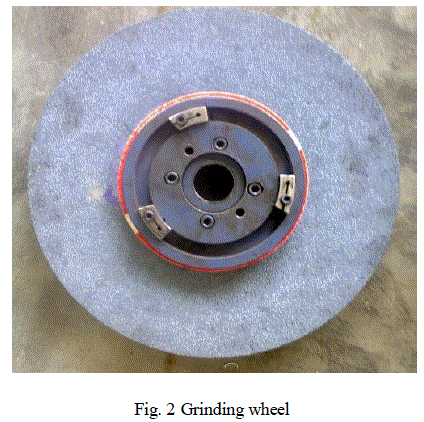 |
IV. RESULTS AND DISCUSSION |
| Experimental result obtained for fluid evaluation is summarized in terms of grinding ratio, grinding efficiency, and specific energy |
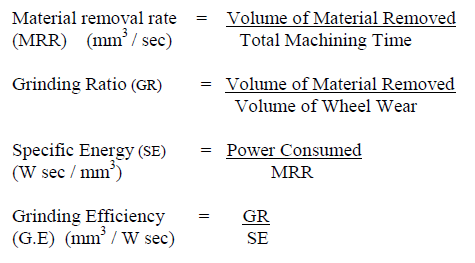 |
| It may be noted that specific energy must be lower and grinding efficiency must be higher for a good performance of grinding process. |
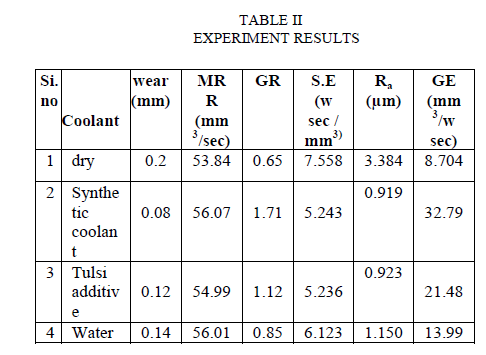 |
| A. Grinding ratio (GR) Grinding ratio is defined as fraction of volumetric material removed by volumetric wheel wear. Tool cost is indicated by grinding ratio; if the grinding ratio is high then more parts are produced effectively between the intervals of dressing. Material removal rate is the volume of material cut per unit time. Productivity increases with increase in material removal rate and tool wear indicates the useful tool life. |
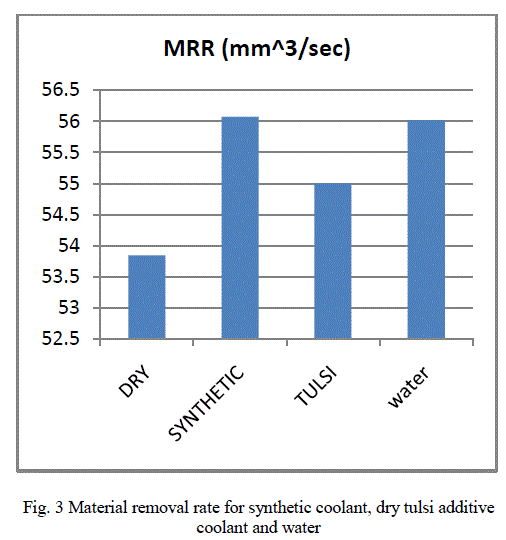 |
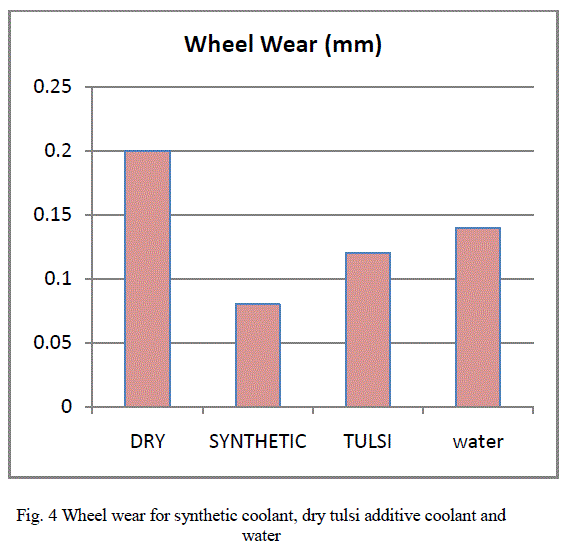 |
| Material removal rate (MRR) graph shows that synthetic coolant has highest material removal rate. Coolant with tulsi additive is much better than dry condition, but when compared to water it declines in rate of removal. From Figure-4, it can be seem that addition of tulsi reduces the wheel wear in comparison to the water and dry condition. From Figure- 5 it can be seems addition of tulsi results in a better grinding ratio than water but not as good as that of synthetic coolant. |
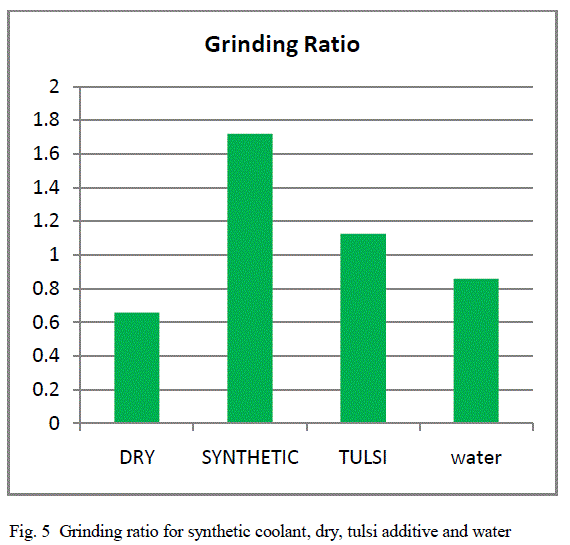 |
| B. Specific energy (S.E) Figure 6 displays the specific energy consumed by each coolant. It can be observed that energy consumed by tulsi additive with water coolant shows nearer to synthetic, which shows that tulsi additive added with water reduce the power consumption. C. Grinding efficiency (GE) Effectiveness of grinding performance is determined by its grinding ratio (wheel life) and specific energy. Grinding efficiency (GE) is described as the ratio of grinding ratio to specific energy. From Figure-7 it can be seem that addition of tulsi has a better grinding efficiency than water but is much below that of synthetic. |
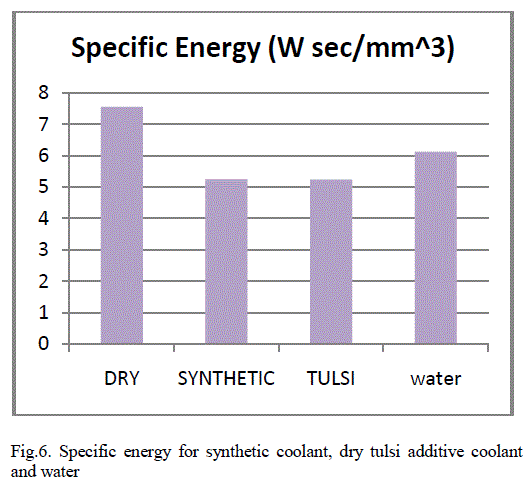 |
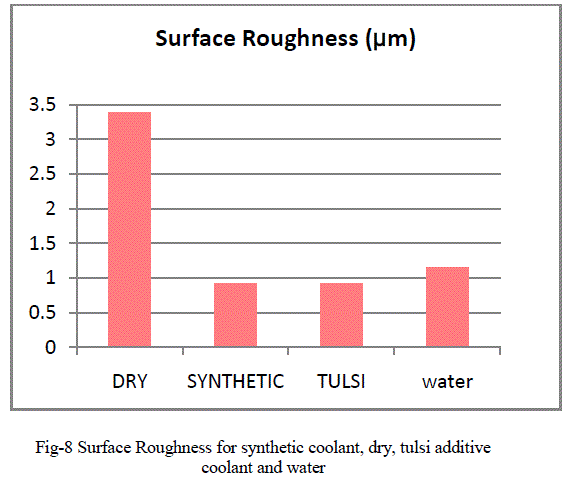 |
V. CONCLUSIONS |
| The performances of four different conditions have been studied and the results show that there is a possibility for replacing the synthetic coolant by water based natural additive coolant. Since water possesses good thermal conductivity and it will not leave any oil prints on the chip and abrasives it can be used as base fluid. Additional properties like corrosion resistance; lubricity etc can be enhanced by adding natural products which satisfy the need as additives. |
| From the above result it is clear that performance of water as a grinding fluid is improved when tulsi powder is added to it. When tulsi is added to water, it is observed that• Wear is less• Grinding ratio is better• Specific energy is better• Grinding efficiency is better However the improvements are slightly less than the synthetic coolant If the concentration of additive is increased there is a chance of further improvement in performance to match that of synthetic coolant [11]. |
References |
|